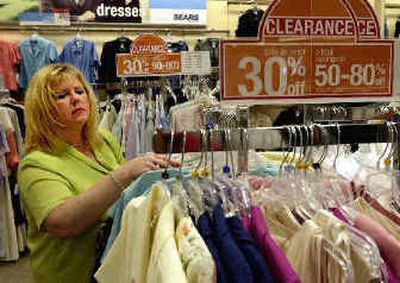Consumers drive retail revolution

The retail industry is undergoing a quiet revolution.
Consider the department store. A decade ago, shoppers could pick up a new sweater at Wanamaker’s in Philadelphia, perfume at the Broadway Store in Los Angeles, a saucepan at Stern’s in Manhattan or a necktie at Goldblatt’s in Chicago. Those names are all gone.
In their heyday, department stores provided everything to everyone — clothes, appliances, housewares, toys and electronics — in a familiar and comfortable environment. But specialty stores now beat them on convenience, and mega-stores beat them on price.
“The competition is just brutally fierce,” said George Whalin, chief executive of Retail Management Consultants in San Marcos, Calif.
Between 1992 and 2003, conventional department store sales grew only 1 percent, while specialty store revenue climbed 70 percent, e-commerce and catalog sales jumped 244 percent, and warehouse store sales leaped 443 percent, according to U.S. Census Bureau data.
Even discounters like Wal-Mart have seen the end of boom times. After enjoying 10 percent sales growth from 1992 to 1993, discount department stores as a class watched growth shrink steadily for a decade, until sales actually fell in 2002 and 2003, census data show.
In an environment in which change is constant, some chains are looking to consolidate. Kmart last year agreed to buy Sears Roebuck for $11.5 billion. Merger talks between Federated and May department stores, which collapsed two years ago, are reportedly on again. Federated operates Macy’s and Bloomingdale’s, and May owns Hecht’s, Lord & Taylor, Meier & Frank and Marshall Field’s.
Certainly, there is much traditional outlets could do to lure customers back to their aisles, such as redesigning floor plans and rewarding loyal patrons, retail analysts say; a well-thought-out merger could cut costs and improve a chain’s bargaining power with suppliers.
But what’s at work here is more fundamental: a sea change in what people buy and how they shop.
“Consumers are time-stressed, and they want convenience and speed,” said Anne Brouwer, a senior partner at retail consultancy McMillan Doolittle in Chicago.
The time shoppers spend on each visit to the mall has fallen from an average 90 minutes in 1982 to 79 minutes in 2002, according to Stillerman Jones & Company, an Indianapolis-based consulting firm.
Instead of walking into a three-level department store, taking the escalator up, and navigating around lingerie to find ladies’ sportswear, women dash into Ann Taylor for the new pair of pants they want.
In department stores, “you can’t walk more than about three feet in a straight line and checkout’s a hassle,” said Stephen Hoch, a professor of marketing at the University of Pennsylvania’s Wharton School of Business.
With their fate tied to the malls they anchor, department stores have suffered as customers flocked to stand-alone outlets such as Home Depot or to “lifestyle centers” — clusters of high-end specialty stores in a pedestrian-friendly setting, often grouped with restaurants and other attractions.
And in the past 20 years, household buying power for the middle class — department stores’ core customer base — has remained pretty flat, Brouwer noted. Chains that have started doing better cater to high-end clientele, who have enjoyed most of the economic recovery from the 2001 recession.
“With the rising cost of housing and health care, people are looking to economize, and where they cut corners is apparel,” said Paco Underhill, a New York-based shopping consultant and author of “Call of the Mall.”
Americans are also spending more money on technology and communications — such as cable television, Internet connections and cell phones — leaving less for clothing, Underhill said.
Finally, there is much more crossover among high-end, middle-range and budget outlets than in the past. Nearly half the monthly shoppers at conventional department stores also shop once a month at Wal-Mart, according to a survey by Retail Forward, a Columbus, Ohio, market research and consulting company.
“A major battle was won in American retail which really transformed the landscape, which is that people lost all shame in shopping at Kmart,” Underhill said. “The woman who bought something at Macy’s in the morning may shop at Costco in the evening.”
The landmark change is that consumers now know they can get better value for their money by shopping around, said Marshal Cohen, chief analyst at the NPD Group, based in Port Washington, N.Y.
The same woman who splurges on a Coach handbag for herself will think nothing of buying her children’s shoes at Target, Brouwer said. “Consumers today, unlike perhaps 15 or even 10 years ago, are very willing to be selective in trading up and trading down,” she said. “They’d rather spend less in one area and more in another.”
With falling labor and product costs, discount and warehouse stores will continue to battle each other and undercut traditional department store prices, Wharton’s Hoch said.
“Department stores are not going to vanish any time soon,” he said, “but they’re going to continue to shrink.”
Retail Forward notes that department stores accounted for only 3 percent of non-auto retail sales in 2003, down from 5 percent a decade earlier. The research firm projects that share will dwindle to 2.3 percent by 2007.
“Although department stores have acted like myopic, sleepy giants for a while, they are waking up and have a much more realistic perspective on their situation,” Retail Forward said in a report on the sector.
New initiatives by department stores, in turn, are likely to make life tougher for other retailers, escalating the already fierce competition, analysts said.